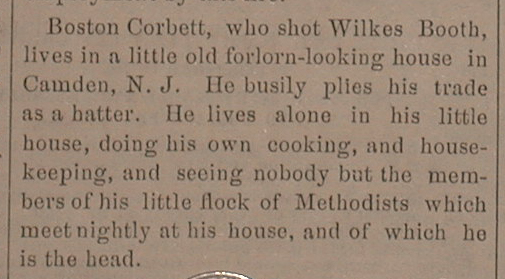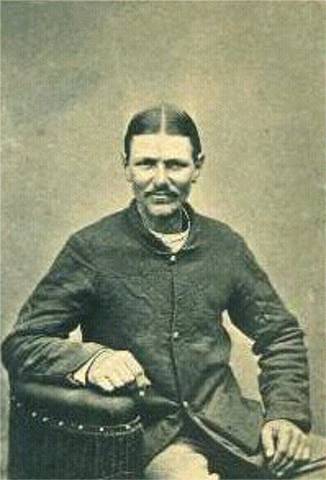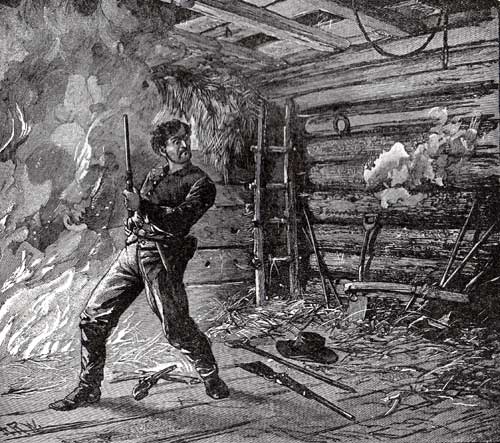|
The Man Who Killed John Wilkes Booth
Thomas H. ("Boston") Corbett was born in London, England, in 1832. Along with his family, he came to New York in 1839. He eventually became a hatter in Troy. He married but his wife died in childbirth. Later he moved to Boston and continued working as a hatter there. (Some have speculated that the use of mercury in the hatters' trade was a causative factor in Corbett's later mental problems.) He became a reborn evangelical Christian while in Boston from which he took a new name. He had been named "Thomas" when born in England. Reform became his purpose in life. Trying to imitate Jesus, he wore his hair very long. Acquaintances considered Corbett to be "different."
One vivid example of Corbett's eccentricity took place on July 16, 1858. Perhaps as a tribute to the loss of his late wife or to avoid the temptation of prostitutes, Corbett took a pair of scissors and castrated himself. He then went to a prayer meeting and ate a full dinner. He took a walk. However, he eventually had to see a doctor. He ended up at the Massachusetts General Hospital and was treated by Dr. R.N. Hodges. The actual hospital record of Corbett's self-castration and treatment still exists. It can be read on p. 59 of the late Dr. John K. Lattimer's book entitled Lincoln and Kennedy: Medical & Ballistic Comparisons of Their Assassinations. |
|
|
Corbett eagerly joined the Union army at the outbreak of the Civil War. He re-enlisted three times finally becoming a sergeant in the 16th New York Cavalry. On April 24,1865, he was selected as one of the 26 cavalrymen from New York's 16th to pursue John Wilkes Booth. On April 26 Corbett and the others cornered Booth in a tobacco barn on the Virginia farm of Richard Garrett. |
 |
David Herold gave up, and detective Everton J. Conger set the barn on fire. Booth remained inside. As Booth moved about inside the burning barn, Corbett shot him with a Colt revolver from a distance of no more than 12 feet. He did this through a large crack in the barn. Corbett, a religious fanatic, explained his actions by saying, "Providence directed my hand." Booth's body was dragged from the barn, and he died a few hours later. His spinal cord had been punctured by Corbett's bullet. Corbett was placed under technical arrest, but the charges were dropped by Secretary of War Stanton. Stanton said, "The rebel is dead. The patriot lives." Corbett received his share of the reward money which amounted to $1,653.85. In his official statement of May 1, 1865, Corbett claimed he shot Booth because he thought Lincoln's assassin was getting ready to use his weapons. |
|
|
Drawing by Alfred Waud |
|
Color Lithograph by Kimmel & Forster (Library of Congress) |
Afterwards Corbett returned to being a hatter, first in Boston at Samuel Mason's shop and later in Connecticut and New Jersey. Feeling threatened at a soldiers' reunion in Caldwell, Ohio, in 1875, he flashed his revolver in the faces of several men who had alleged Booth was not really killed by Corbett.
 From the October 12, 1876, New Hampshire Gazette
In 1878 Corbett moved to Concordia, Kansas. There Corbett lived in a dugout a few miles outside town; the site has been marked by a local Boy Scout troop. His home was stone walled and in a steep hill with a brown stone front and a roof made of brush, clay, and clapboards.
From the October 12, 1876, New Hampshire Gazette
In 1878 Corbett moved to Concordia, Kansas. There Corbett lived in a dugout a few miles outside town; the site has been marked by a local Boy Scout troop. His home was stone walled and in a steep hill with a brown stone front and a roof made of brush, clay, and clapboards.
Corbett's dugout is located southeast of Concordia. To visit the site, drive south on US 81 to the Cloud County Landfill Road, go two miles east, three miles south and one-half mile east. The monument is on the south side of the road in a pasture. The Cloud County Historical Museum has a great deal of information about Boston Corbett. To call the museum dial 785-243-2866.
In Concordia Corbett slept on a homemade bed and kept a variety of firearms. He purchased a flock of sheep. He won local respect for his ability to bring down crows and hawks. Sometimes he gave religious lectures which often turned into wild incoherencies.
In 1887 Corbett was appointed assistant doorkeeper of the Kansas House of Representatives in Topeka. In the state house, on Tuesday, February 15, 1887, feeling paranoid after being threatened by several men in Topeka, Corbett pulled out his revolver, made some threats, and waved his weapon in the air. No one was hurt. Corbett was arrested, declared insane, and sent to the Topeka Asylum for the Insane.
On May 26, 1888, Corbett jumped on a horse that had been left at the entrance to the asylum’s grounds and escaped. He went to Neodesha, Kansas, and stayed briefly with Richard Thatcher, a man he had met during his imprisonment at Andersonville during the Civil War. He said he was heading for Mexico.
Although a few stories exist, there is no absolute proof that Boston Corbett was ever heard from again. He may have gone to Minnesota. His final demise, however, still remains a mystery.
|
|
SOURCE: March/April 1980 edition of Americana |
|
Corbett testified in the conspiracy trial that took place after Lincoln's assassination. He testified on May 17, 1865. In his testimony he explained his shooting of Booth as follows: "Finding the fire gaining upon him (Booth), he turned to the other side of the barn, and got toward where the door was, and as he got there I saw him make a movement toward the door. I supposed he was going to fight his way out. One of the men, who was watching him, told me that he aimed the carbine at me. He was taking aim with the carbine, but at whom I could not say. My mind was upon him attentively to see that he did no harm, and when I became impressed that it was time I shot him. I took steady aim on my arm, and shot him through a large crack in the barn." SOURCE: The Assassination of President Lincoln and the Trial of the Conspirators compiled and arranged by Benn Pitman.
For more information on the shooting of Booth please CLICK HERE.
Thank you to Ned Hostetler for sending me a scan of an old newspaper with the date of Corbett’s weird behavior in the Kansas House of Representatives. Thank you to Steve Fowle, owner and editor of The New Hampshire Gazette (founded in 1756), for sending me the clipping about Corbett. Thank you to Bob Cook for sending the photo of the monument.
|
|
This is not a commercial website. None of the photographs and artwork exhibited herein are being sold by the webmaster. Some photographs and artwork are believed to be in the public domain. Any copyrighted photographs and artwork are used in the context of this website strictly for educational, research and historical purposes only, under the "Fair Use" provisions of the Copyright Act, (US CODE: Title 17,107. Limitations on exclusive rights: Fair Use Section 107). Anyone claiming copyright to any of the posted photographs or artwork please inform the webmaster of such and it will be duly noted or removed.
Questions, comments, corrections or suggestions can be sent to R. J. Norton, the creator and maintainer of this site. All text except reprinted articles was written by the webmaster, ©1996-2019. All rights reserved. It is unlawful to copy, reproduce or transmit in any form or by any means, electronic or hard copy, including reproducing on another web page, or in any information or retrieval system without the express written permission of the author. The website was born on December 29, 1996.
Web design by Andrew Patel.
|






